To begin with: spinning and weaving were important tasks for the vast majority of women in Ancient Greece. Both were a major part of the labour that the typical woman was expected to perform, and were tightly tied into the expectations and the depictions of femininity in Ancient Greece. Several forms of evidence surviving from the period support this conclusion. The primary form of surviving evidence for spinning and weaving – depictions of spinners and weavers – all support the important role that textile production played in the lives and the social roles of women. The depiction of goddesses and heroic mythological mortal women as weavers and spinners indicate how important spinning and weaving must have been to be such a major part of religious text and practice. Outside of mythology, Ancient Greek authors also used spinning and weaving as shorthand for female-gendered labour and activity. This included metaphors to provide context and suggest certain character traits about female characters, providing further insight into the lives of women and their work in the process. Additionally, artistic depictions of the actual process of textile production provide insight into the mechanics of spinning and weaving and their practices. This physical reconstruction is supported by another major form of evidence for spinning and weaving in Ancient Greece: archaeological examples of tools used in spinning and weaving that have survived. These objects and the depictions that provide context for their use are very helpful in verifying and expanding upon the first category of evidence and allow for insight into the actual process of textile production and the difficult labour that played such an important role in the lives of Ancient Greek women. Unfortunately, no actual textiles, first hand accounts, or patterns survive from the time period under consideration [1]. There are also more sources available for Athenian spinning and weaving, making them the primary focus of this survey, with other cities like Sparta, where less evidence exists, relegated to the sphere of comparison [2]. The changes over time are also difficult to discuss; no major changes in textile production or its importance in women’s lives seems to have occurred over the course of the Archaic, Classical, and Hellenistic periods considered here, with a few notable exceptions discussed below. Instead, the practice of textile production and its role in the lives of women must be the general focus of this research, due to the constraints of evidence.
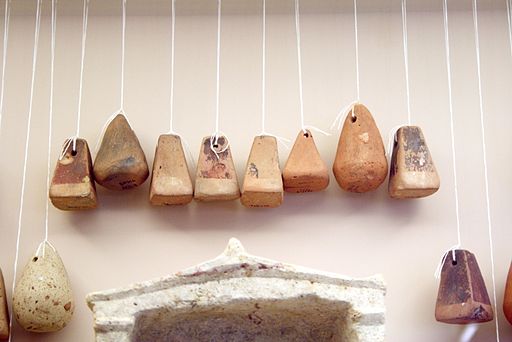
Spinning and Weaving in Myth and Legend
Representations of women, weaving, and spinning, in myths and oral storytelling are particularly interesting because of the potential link between myth and female storytelling. Women, through the female influence on oral storytelling, were far more likely to have been involved in telling or adapting myths and legends than they were in most other depictions of weaving and spinning, such as pots that were likely to have been painted by men, or literature by male authors [3]. This means that the mythological figures prominently associated with weaving and spinning, both mortal and divine, were likely closer to female-driven ideals than other depictions of women as weavers elsewhere in Ancient Greece.
Of the major gods and goddesses, Athena was the goddess of women’s handicrafts, with weaving and spinning being the most important to her cult; they are with her in several prominent myths, in imagery, and in the cult’s rituals and practices [4]. Since Athena was the patron deity of Athens, weaving often held a special place in the religious lives of Athenian women; part of the ritual of the Panathenaia festival was the weaving of a new, elaborate peplos, or long women’s garment, for the statue of Athena Polias that stood in the Erectheion, part of the temple complex on the Acropolis. This was an important and honourable task for the best of Athens’ weavers, as well as the young women that helped carry the peplos and dress the statue [5]. The myth of Arachne is another notable example of Athena’s connection to spinning and weaving. While there are different versions of the myth, in most versions of the story, Arachne is a mortal woman, and an extremely skillful weaver, who boasts that she could best Athena herself. When Athena faces Arachne in a contest of weaving, Arachne emerges as the victor, and Athena turns her into a spider in response, either: 1) as a punishment: 2) so that she can weave for all time: or 3) as recompense for killing her for insulting the gods in some versions of the story [6]. In all versions, the myth provides an origin for the association that spiders had with spinning and weaving, and thus with women. It is also a depiction of a mortal woman and a goddess together as experts in weaving, which is an interesting and unique characteristic.
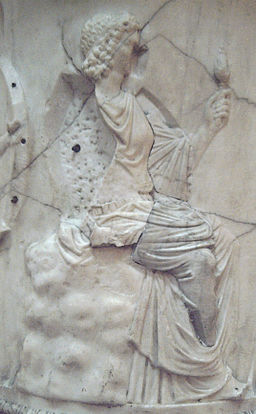
However, Athena is not the only goddess that is depicted in relation to spinning or weaving. Depictions of spinning, in particular, are frequently associated with the Moirai, otherwise known as the Fates, whose process of deciding fate is often explicitly described as spinning, as in the Odyssey and the fate spun for Odysseus [7]. The most common depiction was of three Moirai, spinning, measuring, and cutting the thread of life between them. Of these three named Moirai, the youngest was Clotho, whose name means “spinner” and who thus performs the task of spinning in depictions of the Moirai. Clotho gives great insight into the way that spinning was typically handled by Ancient Greek women, as she holds her implements of spinning, the distaff and the spindle, in depictions of her [8].
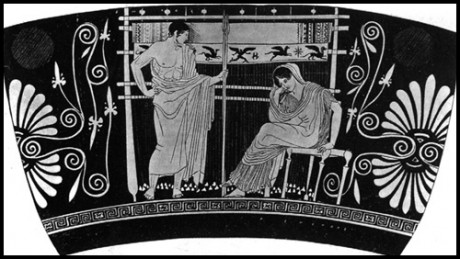
Other than goddesses and the aforementioned Arachne, mortal women are also prominently associated with spinning or weaving in myth. One such mortal woman, who is especially notable for weaving, is Penelope, the wife of Odysseus. Penelope is notable in that her weaving is tightly linked to her role as a faithful wife and exemplifies an ideal of womanhood, but also to cunning and intelligence. In Homer’s Odyssey, Penelope’s primary stalling tactic in fending off her many suitors, and remaining true to her husband Odysseus, is to weave the funerary shroud for her father-in-law every day and unwind her progress each night, a deception that is only revealed to her suitors when another woman informs them [9]. Other mortals commonly associated with weaving are often not so positively depicted, but cunning and weaving remain connected. Circe, another character in the Odyssey, is also linked to weaving, but as a sorceress [10], this time drawing a link not between weaving and faithfulness and industriousness, as was the case with Penelope, but between weaving and inappropriate female cleverness [11].
Spinning and Weaving in Philosophy and Literature
In addition to, and occasionally in combination with, mythological examples, various Ancient Greek authors of drama, history, and philosophy also provide information on spinning and weaving in Ancient Greece through their work, whether directly or as an allusion or metaphor. When the historian Herodotus tells the tale of a particularly industrious woman catching the eye of the Persian King Darius in his histories, for example, she is spinning as she walks [12]. In philosophical texts, mentions of weaving or spinning rarely entail a person performing the act (given that even when characters appear in a philosophical dialogue, they are generally male), but they do provide insight into the perception of women and textile production. Plato goes into an in-depth discussion of the art of spinning, weaving, and making clothes in his Statesman dialogue, as a young man named Socrates and a stranger use spinning and weaving as a metaphor to define the bonds of the realm of statecraft, directly comparing weaving to ruling in the process [13]. Their discussion is enlightening, as weaving is highlighted as the quintessentially feminine activity, as opposed to statecraft as the male activity; simultaneously, they draw a connection between the two in complexity and importance [14]. In dramatic plays, as opposed to philosophical dialogues, where women feature as main characters more frequently, weaving and spinning are more typically included from a first person perspective. In plays like Aristophanes’ Lysistrata or Thesmophoriauzae, the actions of women are the main focus of the plot, and thus it is more natural to allude to the weaving or spinning performed by an actual character. This is the case in Lysistrata, when the title character describes the process of preparing, spinning, and weaving wool textiles for the metaphorical “Cloak of State” [15]. Theatrical works are also interesting in that cloth props are often used and described, providing insight into common forms of textiles.

One such example is found in in Aeschylus’ Agamemnon, where an important scene is commonly dubbed “the carpet scene,” as it revolves around a discussion of a particular piece of purple cloth that would normally be used as an expensive bridal cloth, proceeding to shock the audience when used first as a carpet, and eventually to ensnare the title character of Agamemnon to kill him [16]. This use of the cloth is by Clytemnestra, Agamemnon’s murderous wife, once again suggesting a connection between the malicious cunning of women and the cunning of their work in textiles [17]. More generally, though, literary metaphors strongly link women, textiles, labour, and the household. Xenophon’s compared the home to a cloak or a mantle, and in his Oeconimicus, women are portrayed as “queen bees,” who have resources brought to them from the outside world, like fleece to spin into thread [18]. Of course, it must be noted that the authors that discussed weaving or spinning in Ancient Greek literature in this way are men, and furthermore, they are often using the craft as a metaphor, or as a comment on women’s character or behaviour, rather than discussing weaving or spinning itself. While this does not invalidate what can be learned from the statements of male authors on spinning and weaving, it does call into question what exactly a woman might have felt about the role that weaving or spinning played in her life, as opposed to a male author’s opinion. It also increases the importance of unbiased archaeological evidence in evaluating ancient textile production.
Process of Ancient Spinning and Weaving
Archaeological evidence for textile production includes the implements of spinning and weaving that survive in the material record, as well as images of spinners of weavers. These, combined with the literary depictions, provide insight into the actual function of the craft. The conclusion is that Ancient Greek weaving was very similar to extant practices today.
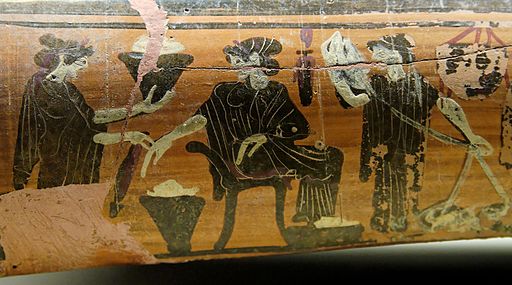
The first, and often most laborious, step of the process entailed wool or another fibre such as flax being cleaned, treated, and broken down into its smallest components in a process that is today called carding, to prepare it for spinning. While modern spinners use bristled carding combs, in the case of Ancient Greece, this involved a comb-like implement, called a kteís, for separating the fibres. They also used a clay vessel called an epinetron, held over the knee, for more easily winding the fibres together into the kátagma, or roving, the treated fibre that is ready for spinning [19]. These epinetron were frequently associated with the start of a young woman’s marriage, and were highly decorated, often with wedding scenes, implying the importance of such tools in a woman’s married life [20]. Wool would have been by far the most common fibre used, and in the case of wool, after it was cleaned the roving was dyed, if desired, gathered, and then the actual spinning process began [21]. The roving was wrapped onto a distaff, or ēlakátē, a staff held under the arm to make the transfer of roving easier; to actually spin the thread, the roving was brought from the distaff toward the spindle, or átraktos [22].
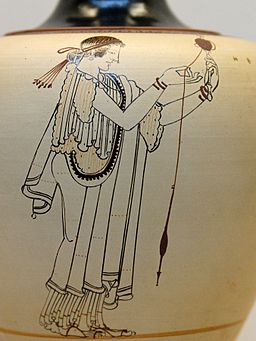
The typical spindle of Ancient Greece is still used today; a drop spindle, consisting of the long, thin staff of the spindle itself; a weight, called a whorl, or a sphóndylos, that allows the spindle to be suspended from the hand and to spin longer for each individual spin; and a hook, called a ánkistron, which guides the spun thread and creates the necessary tension [23]. This process is depicted in many surviving examples of Greek art, including those depicting the aforementioned mythological spinners, but also lekythos and white-ground oinichoe depicting ordinary women spinning, both seated and standing [24]. Equipment also survives; while the distaff and shaft of the spindle were made of wood, and were not preserved, the whorls, made of clay, survive in great numbers, and provide an insight into what precisely spinning would have looked like in antiquity [25]. They were also highly decorated, which implies a certain amount of pride taken in what amounts to be a very small part of the implements used in spinning [26]. Compare to modern spindle whorls, which are generally simple wooden disks.

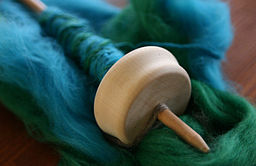
(Aesthetic differences aside, the process from then to now is very much the same, though modern spinners typically do not bother with a distaff.)
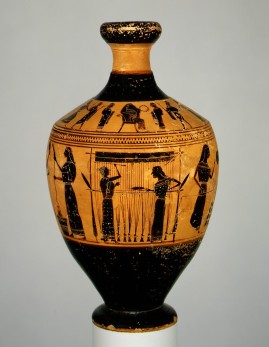
Once the thread was spun, it could be threaded onto a loom, called a histós [27]. Weaving was also an activity generally undertaken in the home, as it was uncommon to purchase fabric made outside the home [28]. In terms of the loom itself, depictions tend to provide a front view of the loom, which portray a standing loom similar to the one depicted below, but not much other detail as to its construction.

However, the depictions, combined with what archaeological and descriptive evidence remains of Ancient Greek looms and ethnographic comparisons, show that the typical loom was probably a standing loom. This likely consisted of a simple wooden frame, probably set up rather like an easel, with upright back legs and an angled stave coming out towards the weaver [29]. The warp threads, or stēmōn, which constitute the backbone of the fabric, would have hung from the top bar of the loom, weighted and kept taut against the angled bottom bar by clay loom weights, called agnŷthes or laiaí, many of which still survive [30]. Once the warp threads were taut, the weft thread, or krókē, would be woven horizontally through the hanging warp using a shuttle, or kerkís, a bobbin holding the weft thread; every second warp would be attached to one of two staves, the kálamos or the kanōn, to create the space through which to weave the shuttle, an operation that constitutes the actual weaving of the textile, before being beaten tighter using a wooden spatula called a spáthē [31]. The final step was fulling, where the cloth was cut down from the loom and treated by pounding the cloth as it was submerged in urine, to treat it with ammonia; this cleaned and thickened the cloth [32]. Modern looms are more complicated. They are generally horizontal, and more mechanized, offering pedals to change the staves holding the warp threads and a channel for the shuttle, making it easier to work on larger pieces of cloth. However, the general principle, as with spinning, remains very similar to the ancient world.
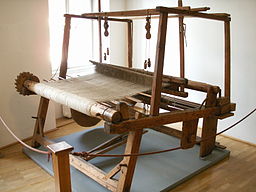
As for the finished product (the actual textiles produced by Ancient Greek women) less is known. Artistic depictions imply that patterned cloth and tapestries were common, and that textile art would have been an important form of artistic expression for women, especially based on accounts of highly detailed textile art in the late Hellenistic period – but no actual examples of patterns survive [33]. This may have been because of the relative lack of literacy among women, and the oral tradition of the skill that was so characteristic of women’s knowledge [34]; this may have meant that no written patterns existed in the first place, or perhaps that the lack of priority on preserving these records means than none have survived.
Lives of Ancient Spinners and Weavers
As for the spinners and weavers themselves, goddesses and queens like Athena, Aphrodite, and Penelope may provide the ideal models for common depictions of spinner and weavers. However, the actual people performing the task of spinning and weaving in an Ancient Greek household varied depending on the structure of the household itself. While purchasing cloth made outside the home was not typical, the person in the home producing the cloth was not necessarily the person who would wear it. Few women were able to live lives where spinning or weaving was not an expected task, but exceptions did exist, such as Spartan citizen women, whose workload was very different from that of women in the rest of Ancient Greece, this was due largely to the captive Messenian population replacing the citizen workforce in many household duties [35]. However, Sparta is not the only place where slaves were important contributors to the labour of spinning and weaving, only the example where they seemed to have mostly replaced citizen women. Female slaves would have been expected to do a certain amount of spinning each day as part of their labour, as well as a large amount of the day-to-day textile production for wealthy Greeks, leaving wealthier women to apply themselves to textile arts [36]. Even male slaves wove, and though they were generally the only men to do the work of spinning or weaving, there was apparently an economy for commercially produced weaving available for those without female relatives or slaves to do the work, which may have occasionally led to textiles produced by male craftsmen [37]. Ancient textile production formed an essential aspect of life in Ancient Greece, and an especially important part of the lives, labour, and perception of Ancient Greek women, but it does serve to remember that the lives of those involved in the labour were not created equal.
Bibliography
Aristophanes. (2000). Lysistrata. (J. Henderson, Trans.). Cambridge: Harvard University Press.
Blundell, S. & Rabinowitz, N. S. (2008). Women’s bonds, women’s pots: Adornment scenes in ancient Attic vase-painting. Pheonix, 62(1), 115-144.
Cancik H. & Schneider H. (Eds). (2009). Moirai. Brill’s new pauly encyclopedia of the ancient world (Vol. 9). Boston: Brill.
Cancik H. & Schneider H. (Eds). (2009). Textile production. Brill’s new pauly encyclopedia of the ancient world (Vol. 14). Boston: Brill.
Cole, E. B. (1991). Weaving and practical politics in Plato’s Statesman. The Southern Journal of Philosophy, 29(2), 195-209.
Fleck, R.K. & Hanssen, F.A. (2009). “Rulers ruled by women”: an economic analysis of the rise and fall of women’s rights in ancient Sparta. Economics of Governance, 10(3), 221-245.
Heath, J. (2011). Women’s work: Female transmission of mythical narrative. Transactions of the American Philological Association, 141(1), 69-104.
Herodotus. (2000). The Histories (Vol. III). (A.D. Godley, trans.) Cambridge: Harvard University Press.
Jenkins, I.D. (1985). The ambiguity of Greek textiles. Arethusa, 18(2), 109-133.
Karanika, A. (2014). Voices at work: women, performance, and labor in Ancient Greece. Baltimore: Johns Hopkins University Press.
McNeil, L. (2005). Bridal cloths, cover-ups, and kharis: the ‘carpet scene’ in Aeschylus’ Agamemnon. Greece and Rome 52(1), 1-17.
Endnotes
[1]: Cancik &Schneider, 2009, vol. 14, p. 343.
[2]: Fleck and Hansen, 2003, p. 223.
[3]: Heath, 2011, p. 70.
[4]: Karanika, 2014, p. 85.
[5]: Ibid.
[6]: Karanika, 2014, p. 5.
[7]: Homer, The Odyssey, Book VII, 233, Fagles.
[8]: Cancik & Schneider, 2009, Vol. 9, p. 125.
[9]: Homer, The Odyssey, Book XXIV, 139-51, Fagles.
[10]: Homer, The Odyssey, Book X, 244-5, Fagles.
[11]: Jenkins, 1985, p. 111.
[12]: Herodotus, The Histories, Book V, Chapter 12, 2, A.D. Godley.
[13]: Plato, Statesman, 297b, H.N. Fowler & W.R.M. Lamb.
[14]: Cole, 1991, p. 196.
[15]: Aristophanes, Lysistrata, 578, J. Henderson.
[16]: McNeil, 2005, p. 2.
[17]: McNeil, 2005, p. 4.
[18]: Jenkins, 1985, p. 110.
[19]: Cancik & Schneider, 2009, vol. 14, p. 342.
[20]: Blundell & Rabinowitz, 2008, p. 133.
[21]: Jenkins, 1985, p. 110.
[22]: Cancik &Schneider, 2009, vol. 14, p. 342.
[23]: Cancik &Schneider, 2009, vol. 14, p. 343.
[24]: Ibid.
[25]: Ibid.
[26]: Ibid.
[27]: Ibid.
[28]: Jenkins, 1985, p. 110.
[29]: Cancik &Schneider, 2009, vol. 14, p. 343.
[30]: Ibid.
[31]: Ibid.
[32]: Ibid.
[33]: Cancik & Schneider, ed. 2009, vol. 14, p.339.
[34]: Heath, 2011, p. 70.
[35]: Fleck & Hanssen, 2009, p. 223.
[36]: Cancik &Schneider, 2009, vol. 14, p. 343.
[37]: Thompson, 1982, p. 220.
Interesting topic and great amount of detail… so much research 😱 the pictures are really informative too!
LikeLiked by 1 person
Interesting topic and great amount of detail… so much research 😱 the pictures are really informative too!
LikeLiked by 1 person
Interesting. Do we have anything in the way of evidence about the textile market: what was made in home vs what was made for public use? Asides from the occasional childless widowers needing someone to weave their clothes for them, what about large cloth objects like sails, tapestries, and carpets (how common were the latter two, were these all also made in the home)?
LikeLiked by 2 people
Really nice to know how textiles have evolved over time
https://trackton.in/
LikeLiked by 1 person
Good job. I wonder if you have continued with similar research in the years since this project was published.
LikeLiked by 1 person
At the risk of blowing my own horn, see Dangerous Gifts: gender and exchange in ancient Greece (2012)
LikeLiked by 1 person